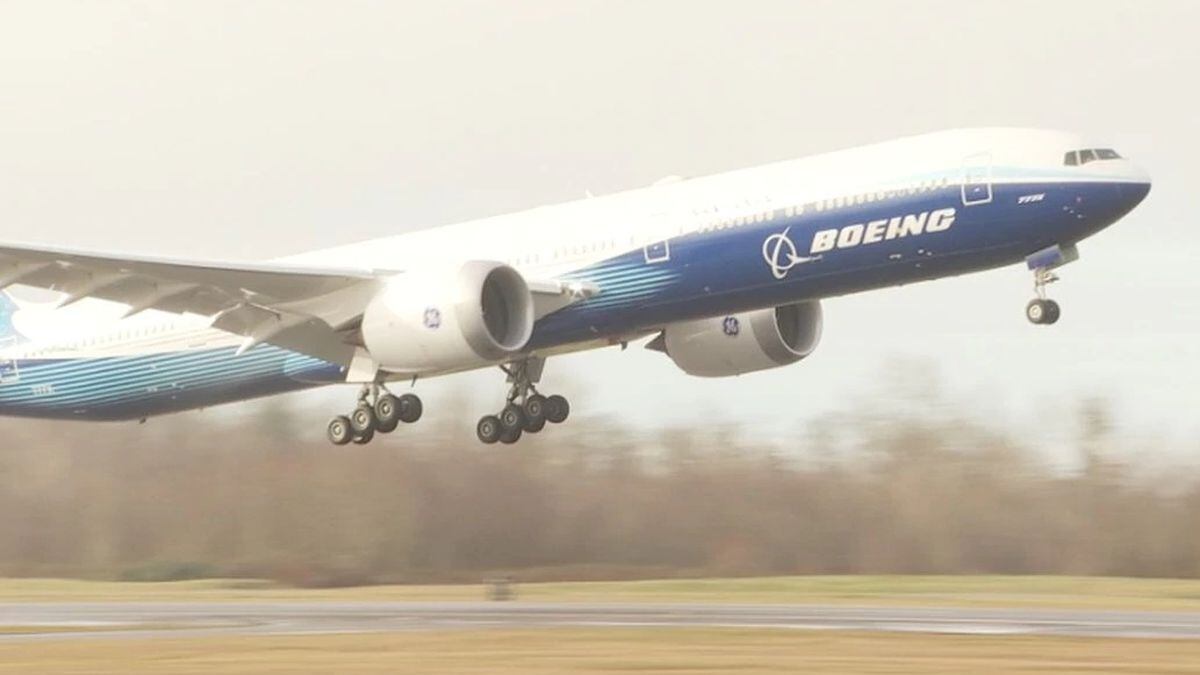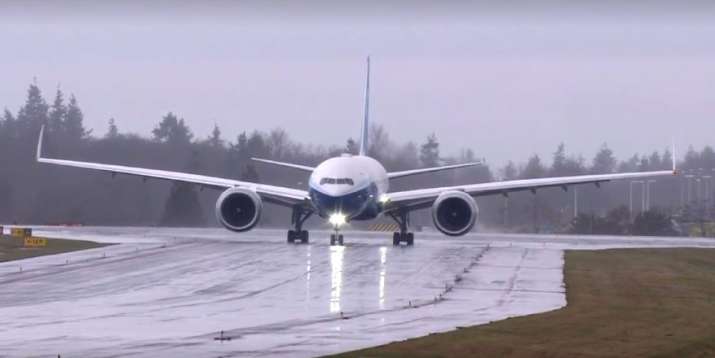- Boeing 777x First Flight Videos
- Livestream Boeing 777x First Flight
- Boeing 777x Test Flight Schedule
- First Flight Of Boeing 777x
In the next phase of the rigorous test program, the plane will take its first flight. This flight will be conducted by the aircraft with the registration number N779XW. It is a variant of the 777-9. The 777X will take off from Paine Field, which is the right next to Boeing’s Everett factory, for its first flight.
- First delivery of the Boeing 777X is due in 2020. Courtesy Boeing Boeing says the 777X will provide flexibility for airlines, part of its vision for the future of aircraft.
- The 777X, a program launched back in November 2013, is the successor to the most successful wide-body airliner ever built: the 777, which first entered service nearly 25 years ago.
After two failed attempts, called off due to high winds, the latest addition to the 26-year-old Boeing 777 family has finally taken to the air. At 09:08 am, Saturday 25 January 2020, aircraft registration WH-001 started its takeoff run on runway 34 Left at Paine Field, Everett. With an 8 knot tailwind, broken clouds at 3,000 feet with 6 miles visibility, the largest twin-engine jet took a mere 30 seconds to become airborne. Applause and cheering from the crowd was drowned out by the worlds biggest jet engines, the GE Aviation GE9x.
Maiden flights of new airliners don’t happen very often, maybe once or twice a decade. Whilst the first flight of the Boeing 777x is a cause for excitement, Boeing must be feeling the pressure of getting this completely right in light of the 737 MAX situation. But enough of that.


The test flight lasted four hours out over the Pacific Northwest, a major milestone and the beginning of a very rigorous aircraft certification program. Before the aircraft can be delivered to airlines and begin carrying passengers, it has to go through a certification process. This is done with the F.A.A. (Federal Aviation Administration) and then no doubt with other agencies such as E.A.S.A. (European Union Aviation Safety Agency) before it can fly to, or overfly those regions. By current estimates, Boeing expects to be in a position to start delivering the first aircraft to customers in 2021. The first of those is expected to be Emirates. The order book for the 777x stands at 309 airframes with a list price of US $442M per aircraft. Of course, this is not necessarily what airlines will pay as they will have negotiated with Boeing for discounts around things like, number of aircraft ordered, or being the launch airline. Nevertheless, the sooner Boeing starts delivering, the sooner the income for this project will start.
So after 26 years of 777s (Tripple Sevens), what is so special about the 777x? Well, the original 777 was a step forward in its day, being computer designed it brought a lot of new ideas to the airliner design table. The 777x is carrying on that tradition by using technologies that have been tried and tested in the Boeing 787 Dreamliner. This includes using more composite materials in its construction, to make use of lighter stronger materials as well as materials which are far less susceptible to corrosion. Larger windows and an updated passenger cabin will be great news for passengers on this aircraft that Boeing maintains is the most efficient twin-engined airliner in the world.
___________________________________________________________________

The standout feature is the folding wingtip………
___________________________________________________________________
The stand out feature, however, is the folding wingtip. This feature, until now, was typical of fighter aircraft that were assigned to aircraft carriers. To save space when the aircraft was stored below decks, its wings would be folded upwards and thereby reducing the side to side space required for its storage. This is a concept that Boeing went with. To create the largest twin jet in the world, that is required to fly further than the previous version, was going to require a wing that gave more lift than the previous version. Winglets could have solved the problem to some extent, but it has been found that a longer tapered wing gives more optimal lift. The Boeing 787 and the Boeing 747 8 are testament to Boeing’s findings in this area.
So why folding wingtips? Well, let’s look at the Airbus A380. When it was introduced in the early 2000s, airports were required to make adjustments to gate areas to enable a much wider aircraft to be accommodated. They had to be “A380 Ready” before that airliner could land there. A huge upheaval and expense but it was seen as the new future and therefore was seen as an investment in that future. We now know of course that the days of the A380 are numbered, now that the giant twin airliners are coming of age. Boeing wanted to avoid the restrictiveness of requiring airports to upgrade to be able to handle an oversized wingspan. They wanted the 777x to be able to fly everywhere that the current generation of 777s can fly to. So was born the folding wingtip idea. The wingtips allow the 777x to change from a wingspan of 235 feet in the air down to 213 feet on the ground.
As the wingtips are a totally new technology in the passenger airliner space, the F.A.A. has come up with a set of 10 conditions that have to be satisfied before certification can take place. Boeing has stated that the non-deployment of the wingtips on takeoff can lead to catastrophic results. This is logical, as a fully laden aircraft, depends on the lift that those wingtips provide. If you suddenly have smaller wings than required, you are going by road with tragic results. The 10 conditions are designed to put fail-safes in place to
_________________________________________________________________
… you are going by road with tragic results……..
_________________________________________________________________
Boeing 777x First Flight Videos
prevent the non-deployment of wingtips on takeoff as well as the failure of the wingtips to stay in place during flight. These conditions revolve around a comprehensive warning system to alert the crew to the fact they are attempting takeoff without the wingtips deployed. In addition, if that is ignored, there is the ability for the aircraft to prevent takeoff until wingtips are deployed. With every new technology comes a whole raft of things to consider and conditions to be tested for.
Like the Boeing 787 Dreamliner which started its early days as the 7E7, the 777x will no doubt be dropped in favour of the actual variant names of 777-8 and 777-9. Some basic statics on the two models are as follows:
Livestream Boeing 777x First Flight
Be sure to visit our Boeing 777x page for more details.
At 251 feet, the Boeing 777-9 will be the longest commercial aircraft in the world.
The road to this first test flight has not been a smooth one. From the time that the 777x was first rolled out of the hangar in March 2019, it was found that the new GE9x engine experienced excessive wear when run. In September when the wing stress testing was done, there was an explosive decompression event when a tear appeared in the fuselage. The manufacturing of the 777x was to be done in a fully automated assembly line by robots. Challenges in this area have forced Boeing to revert back to the traditional human-driven process.
The 777x is in the air at last. We certainly look forward to watching its progress toward certification.
Boeing’s latest airliner, the 777X, which is the largest twin-engined jet ever developed, made its maiden flight this weekend, signalling that aircraft is entering the next phase of its test program.
Test aircraft WH001 took off from Paine Field in Everett, Washington, at 10:09am local time on January 25 for a three hour, 51 minute flight over Washington state before landing at Seattle’s Boeing Field. The flight was postponed twice on January 23 and January 24 because of high winds.
WH001 is the first of four 777-9 flight test airplanes and will now undergo checks before resuming testing in the coming days. Ground testing of all the test aircraft began in Everett last year and will continue alongside flight testing over the coming months, said Boeing.
The 777X is Boeing’s first commercial jet to feature folding wingtips, which extend its wingspan from 212 ft (64.8 m) to 235 ft (71.8 m) while taking-off and in the air. The smaller wingspan of the 777X while on the ground enables the aircraft to fit in at airport gates and hangars that Boeing’s successful 777 widebody airliner currently uses, while enabling it to be larger than its predecessor.
Captain Van Chaney, 777/777X chief pilot for Boeing Test & Evaluation said, “The 777X flew beautifully, and today’s testing was very productive. Thank you to all the teams who made today possible. I can’t wait to go fly your airplane again.”
During the flight Chaney and Boeing chief pilot Craig Bomben worked through a test plan for the airplane’s systems and structures while a team in Seattle monitored the data in real time.

Stan Deal, president and CEO of Boeing Commercial Airplanes said, “Today’s safe first flight of the 777X is a tribute to the years of hard work and dedication from our teammates, our suppliers and our community partners in Washington state and across the globe.”
According to Boeing, the 777X twin-engined widebody commercial passenger jet will deliver 10% lower fuel use and emissions and 10% lower operating costs than comparable aircraft on the market thanks to improved aerodynamics, a carbon-fiber composite wing and the use of the GE Aviation’s GE9X, the world’s largest commercial jet engine. The 777X will compete with Airbus’ A350-1000.
Boeing 777x Test Flight Schedule
The 777X includes the 777-8 and the 777-9, seating 384 and 426 passengers with ranges of 8,730 nautical miles (16,170 km) and 7,285 nautical miles (13,500 km) respectively. Airlines have ordered 340 777Xs and Boeing plans to deliver the first in 2021.
The successful first flight is an important milestone for Boeing at a time when the company is suffering badly from the continuing fallout from the 787 Max crashes in 2018 and 2019, which have grounded the existing fleet of aircraft and stopped production. The 777X program has also been delayed because of problems with the GE9X engine.
Development of the 777X started in 2013 and static testing of the aircraft started in September 2018.

First Flight Of Boeing 777x
For detailed information on the 777X and all other major commercial aircraft development programs go here.